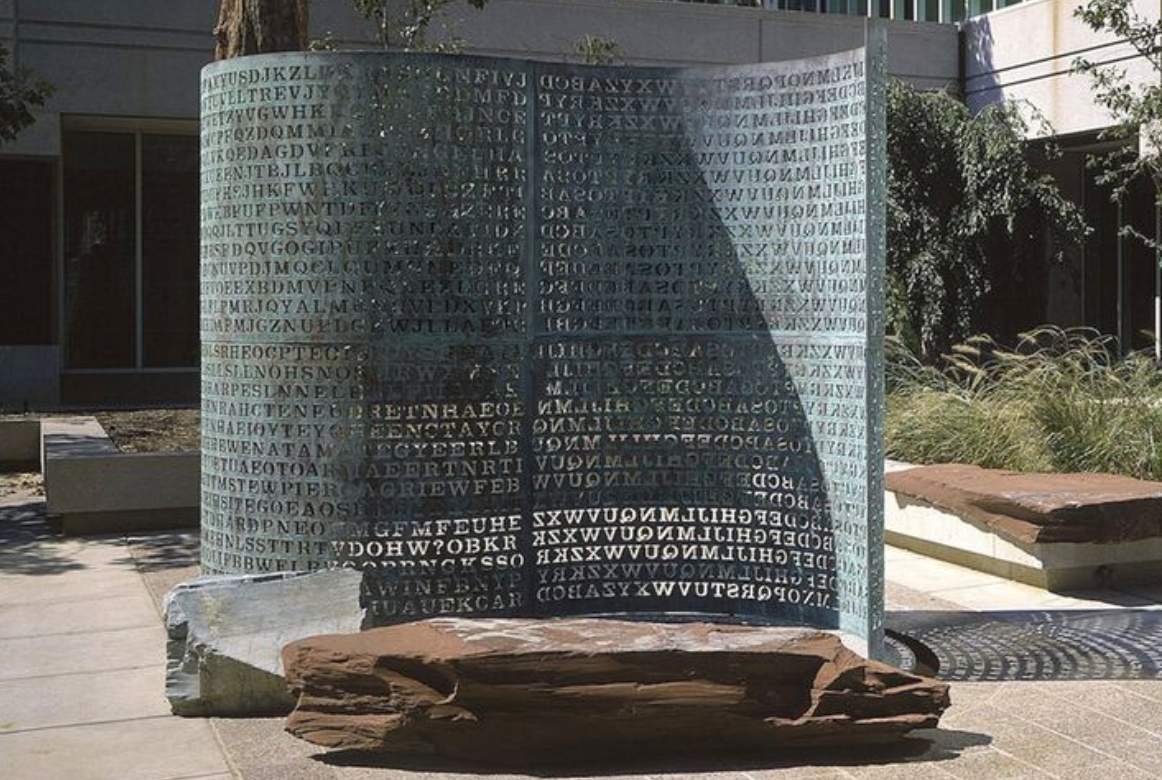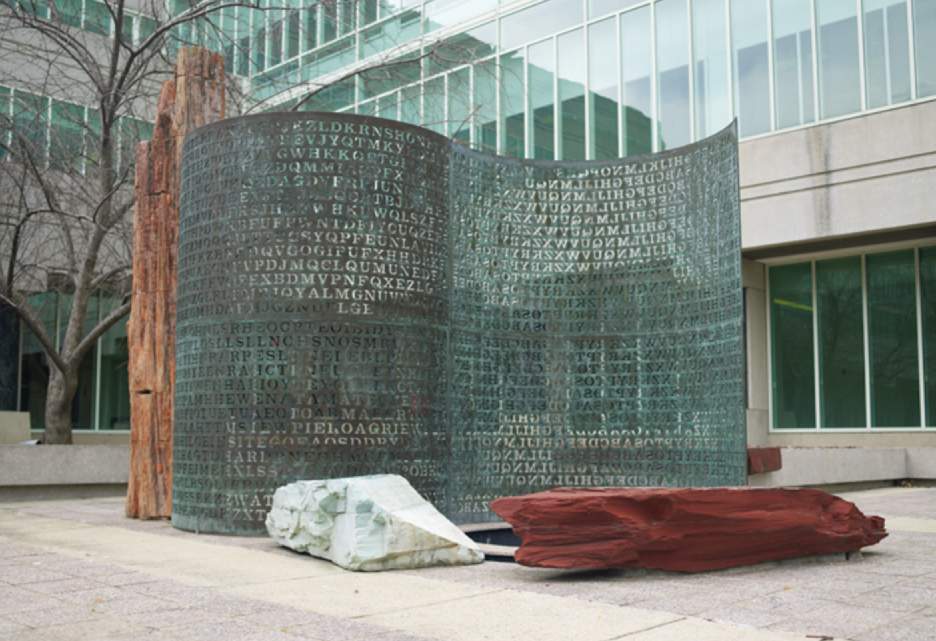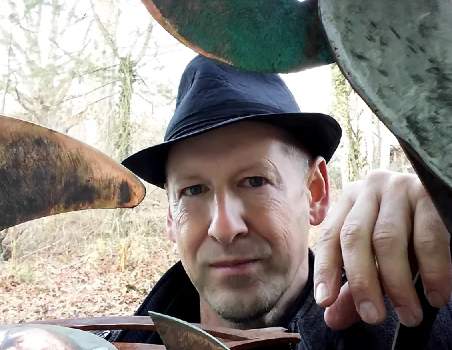Kryptos: The Cryptic CIA Mystery Is Bigger Than You Think
Interviews with former CIA officer and SPYEX consultant Douglas Patteson and artist David Sheldon shed light on the enduring mystery of the coded CIA sculpture known as Kryptos.
The CIA’s Kryptos installation is much larger than the snaking copper sheet containing four coded panels that have transfixed the world’s cryptologists, mathematicians, and amateur code-crackers for more than 30 years. Only three of the four Kryptos code panels have been cracked. The final panel - containing 97 of the world’s most exasperating letters - is unsolved.
Kryptos sculptor Jim Sanborn wasn’t offering any clues about how to decipher the remaining panel when SPYSCAPE contacted him, although he had two words of advice: “Work Harder!”
Perhaps a clue lies in examining the artwork in its entirety, however. Kryptos is much larger than the copper structure. It is actually spread out across the CIA ‘campus’ in Langley, Virginia in three main sections known by code crackers as Courtyard Plaza (where the copper sculpture sits), Courtyard Lawn (where granite juts out of the grass), and the CIA Entrance which displays granite sheets.
“Out front, on the campus grounds, is a monumental earthwork, comprised of enormous granite sheets jutting out of the earth, evoking shifting strata of earth exposed,” according to artist David Sheldon, who was Jim Sanborn’s assistant in 1990 when Kryptos was dedicated.

Building Kryptos
Sheldon was fresh out of grad school having studied art at the University of Maryland when Sanborn hired him to help cut out Kryptos’ 1,800 or so letters. Sheldon’s days involved removing three-inch-high vowels and consonants from a .25-inch thick copper plate, work he described as ‘grueling’ and ‘thrilling’.
Sheldon also accompanied the sculptor to the CIA grounds to help Sanborn with the installation. “I'm a very driven artist, myself, and appreciate hard, physical work. I loved the idea of being able to help out with such a major work of art.”

There is more to Kryptos than meets the eye
“The part of the installation that you see in the photo (above), with the copper sheets and lettering - along with sections of a large, petrified tree - is just one aspect of the installation. One can't see from the photo, but the sheeting wraps around a swirling pool of water at its base,” Sheldon said.

"The brand new social experience where you activate your gaming skills as you train like a spy."
- TimeOut
Take on thrilling, high-energy espionage challenges across different game zones.

Kryptos’ mysterious water, stone, and granite
“There's also a water element and deposit of stone nearby,” he added. But what about the rarely photographed granite sheets he mentioned near the entrance to the CIA? Are they also coded? Sheldon says no: “The copper sheets and lettering, as seen in the photo, is the only part of the installation that contains the messages.”
Is he sure there are no other messages? Perhaps a photo of a granite slab adorned with Morse code might jog Sheldon’s memory. “Lol - thanks for the pic,” Sheldon emailed back. “I had a vague memory of that included, but didn’t want to say so, and be wrong about it.”

Kryptos: Morse code and mystery
Photos taken by cryptography and computer scientist Jim Gillogly' show granite slabs outside of a CIA building, one is inscribed with a compass and another slab is inscribed with Morse code in a layer of copper.
“It is not completely clear whether or not those pieces are key to the 4th passage (or interpretation of the riddle once the 4th passage is solved),” said former CIA officer and SPYEX consultant Doug Patteson. “It is also unclear what the role of the compass rose on one of the slabs is in all this.”
“The current CIA museum director has publicly stated that these outlying pieces are part of overall Kryptos structure, though I do not believe Sanborn has addressed that publicly,” Patteson added.
Cryptographer Elonka Dunin, an expert on Kryptos, posted ‘birds eye view’ photos of the CIA campus online. According to Dunin, the entrance walkway includes large stone slabs. “Some have a sandwiched sheet of copper with various Morse code messages. Another has a large engraved compass which seems to be pointing at another stone nearby, which may be a lodestone.”
Kryptos: The art of spying

Artist David Sheldon wasn’t privy to the coded messages developed by sculptor Jim Sanborn, but he was aware that suspected code breakers - cameras in hand - were peering into the studio windows in the evenings before Kryptos was dedicated in 1990.
No clues were revealed, however.
Looking back on Kryptos after more than 30 years, Sheldon appreciates the perpetuation of a good mystery. “Art, to me, is about keeping mystery and questions 'alive', so I can respect keeping Kryptos’ seemingly impenetrable secrets alive and well.”
SPYSCAPE+

Join now to get True Spies episodes early and ad-free every week, plus subscriber-only Debriefs and Q&As to bring you closer to your favorite spies and stories from the show. You’ll also get our exclusive series The Razumov Files and The Great James Bond Car Robbery!


Gadgets & Gifts
Explore a world of secrets together. Navigate through interactive exhibits and missions to discover your spy roles.
Your Spy Skills
We all have valuable spy skills - your mission is to discover yours. See if you have what it takes to be a secret agent, with our authentic spy skills evaluation* developed by a former Head of Training at British Intelligence. It's FREE so share & compare with friends now!
* Find more information about the scientific methods behind the evaluation here.


Stay Connected
Follow us for the latest
TIKTOK
INSTAGRAM
X
FACEBOOK
YOUTUBE